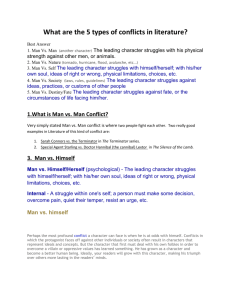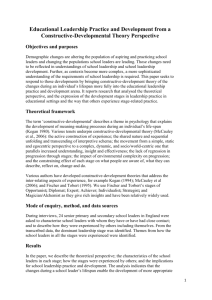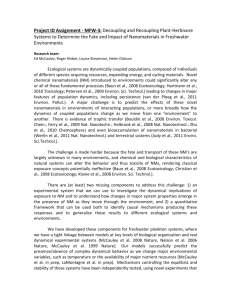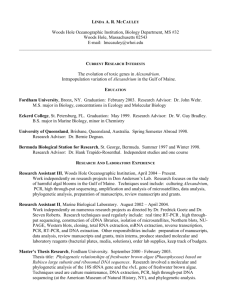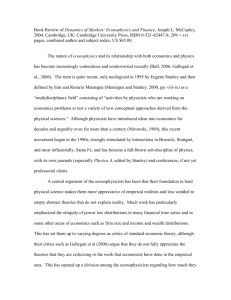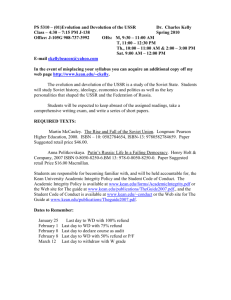1942/97 - Maryland Courts
advertisement
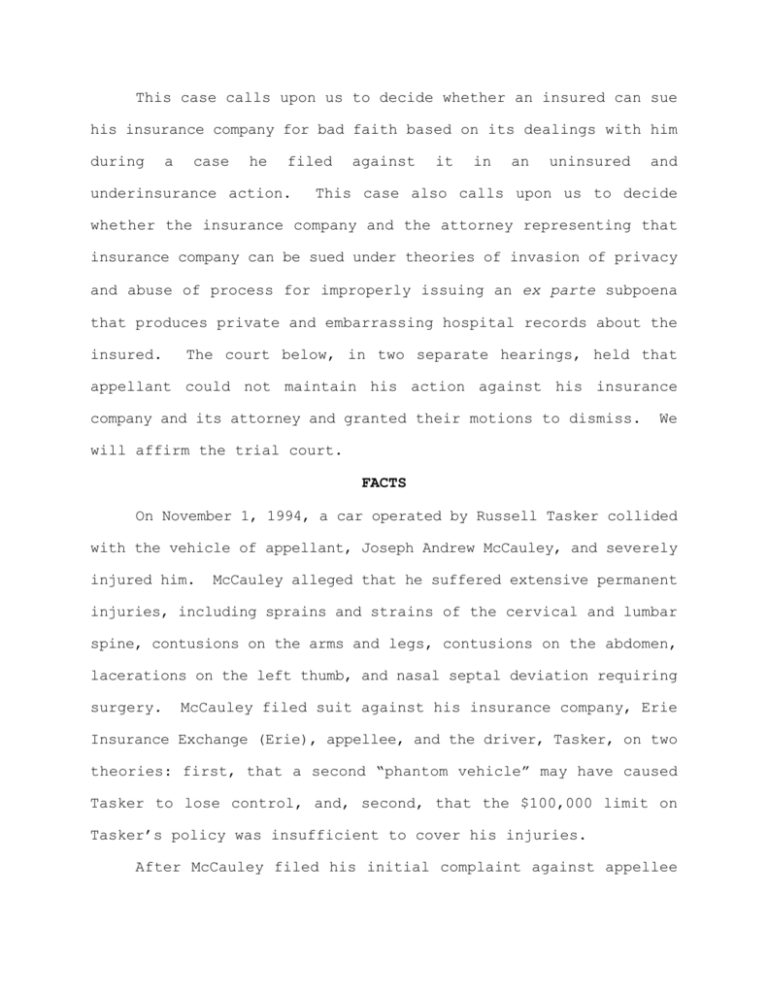
This case calls upon us to decide whether an insured can sue his insurance company for bad faith based on its dealings with him during a case he filed underinsurance action. against it in an uninsured and This case also calls upon us to decide whether the insurance company and the attorney representing that insurance company can be sued under theories of invasion of privacy and abuse of process for improperly issuing an ex parte subpoena that produces private and embarrassing hospital records about the insured. The court below, in two separate hearings, held that appellant could not maintain his action against his insurance company and its attorney and granted their motions to dismiss. We will affirm the trial court. FACTS On November 1, 1994, a car operated by Russell Tasker collided with the vehicle of appellant, Joseph Andrew McCauley, and severely injured him. McCauley alleged that he suffered extensive permanent injuries, including sprains and strains of the cervical and lumbar spine, contusions on the arms and legs, contusions on the abdomen, lacerations on the left thumb, and nasal septal deviation requiring surgery. McCauley filed suit against his insurance company, Erie Insurance Exchange (Erie), appellee, and the driver, Tasker, on two theories: first, that a second “phantom vehicle” may have caused Tasker to lose control, and, second, that the $100,000 limit on Tasker’s policy was insufficient to cover his injuries. After McCauley filed his initial complaint against appellee Erie, Robert A. Suls entered his appearance as the attorney for Erie and began to conduct discovery. McCauley informed Suls, in interrogatories, that Carroll County General Hospital (CCGH) had hospitalized him in November 1992 for a bacterial skin infection. Although Suls had requested all documents referred to in his interrogatories, McCauley did not produce the hospital records. Suls questioned McCauley about his medical history during depositions and McCauley told him that CCGH hospitalized him for a “staph infection.” Subsequent to the deposition, Suls issued several subpoenas1 on July 16, 1996, including one to CCGH for McCauley’s medical records and one to McCauley’s employer for its records. 1 The return Before a change in the rules in 1984, in order to obtain a subpoena, a party or counsel filed a request directed to the Clerk of the Court and asked that a subpoena issue. The Clerk would then stamp the request or issue its own subpoena. , Under Md. Rule 2-510(b), as amended in 1984, this method continues; however, the Clerk may also issue blank forms of subpoenas, signed and sealed, to attorneys or other officers of the court. The attorney or officer fills out the necessary portions and has the subpoenas served. Out of a concern that this privilege would be abused, the rule specifically prohibites the use of subpoenas, except to compel attendance and production of documents, either for a court proceeding or deposition. . It appears that there were reports of abuse, notwithstanding the limitations specified in the rule, and, effective July 1, 1998, the rule was amended specifically to provide that an opposing party may file a motion alleging that a party or an attorney used or attempted to use a subpoena for a purpose other than that allowed by the rule. If the court, after a hearing, finds that a subpoena was improperly used, it may impose an appropriate sanction on the party or attorney, including the award of reasonable attorney’s fees and costs, exclude the evidence obtained by the subpoena, and reimburse any person inconvenienced for time and expenses incurred. Here, Suls issued the subpoenas, apparently, without scheduling depositions and notifying opposing counsel. Suls has maintained that his failure to send the notices of depositions was mere oversight. We are not called upon to decide whether Suls’s actions were advertent or inadvertent; however, we note that Suls’s failure to provide notice precluded McCauley from objecting to the production of the documents or filing a motion for protective order pursuant to Md. Rule 2-403, and Suls was able to obtain the documents through an “ex parte” subpoena. 2 date for the subpoenas was August 19, 1996. On or about July 22, 1996, McCauley learned about one of the subpoenas through his employer and informed his attorney, Mr. Shapiro, that his employer had received a subpoena from Suls for his personnel records. July 26, subpoenas. 1996, Shapiro telephoned Suls to inquire about On the Suls indicated that it was then that he realized that he had failed to send notices of deposition relating to the subpoenaed records and informed Mr. Shapiro about outstanding subpoenas, in particular the one to CCGH. the other Suls also informed Shapiro that he had received records from McCauley’s employer, but he had not yet received the records from CCGH. Suls told Shapiro that he was leaving for vacation, but that he would instruct his staff to send out copies of the subpoenas, and his office did so on July 31, 1996. While Suls was on vacation, his office received the subpoenaed records from CCGH which bore a certification date of July 31, 1996. On August 6, Suls returned, confirmed the source of the records, and, without reviewing them substantively, placed them in sealed envelopes. On August 7, 1996, Suls wrote to Shapiro and indicated that he wanted “to restore the parties to status quo.” He asked Shapiro to advise him, within fifteen days, about the records resulting from the subpoenas sent without notices. If Shapiro advised, Suls would reissue the subpoenas and notices so that counsel could take any appropriate action. If counsel filed a motion to quash, Suls 3 offered to “return, destroy, or place with the court under seal any document which should not have been produced.” Suls wrote that if counsel did not contact him within fifteen days, he would “presume there is no dispute regarding the documents produced,” and that he would then review the documents and make them available to counsel. Shapiro next contacted Suls by letter dated August 21, 1996, asking that Suls forward the records “that have been spawned as a result of the Subpoenas which you filed without sending notices.” Suls complied and sent Shapiro a copy of the records. McCauley never sought any relief from the court for any discovery violation and did not file a motion to quash or for protective order. Nevertheless, because Suls failed to notify McCauley’s attorney about the subpoenas, McCauley filed a second complaint against Suls and Erie, alleging invasion of privacy, fraud, civil conspiracy, and bad faith.2 PROCEEDINGS BELOW After McCauley filed his complaint, Erie and Suls filed motions for dismissal or for summary judgment and McCauley filed his opposition and an amended complaint, adding a claim for abuse of process. Erie and Suls again filed motions for dismissal or for summary judgment. Judge William Hinkel of the Circuit Court for Baltimore County granted the motions with prejudice as to the 2 The underlying action against Erie alleging underinsurance and uninsured claims was settled before reaching trial. 4 claims for invasion of privacy, fraud, civil conspiracy, and bad faith, but allowed McCauley leave to amend his abuse of process claim. After McCauley amended his complaint, Erie and Suls again filed motions for dismissal or for summary judgment, and Judge Lawrence R. Daniels granted the motions on October 27, 1997. McCauley appeals from those decisions and asks: I. Did the trial court err in granting the motions as to appellant’s claim of first party bad faith? II. Did the court err in granting the motions on appellant’s invasion of privacy claim? III. Did the court err in granting the motions as to the claim of abuse of process? We answer “no” to all three questions and, accordingly, affirm.3 ANALYSIS Before we can resolve any of the issues raised by McCauley, we must first determine how the trial judges disposed of the instant case, and then apply the appropriate standard to the courts’ decisions. McCauley argues that both trial judges who heard the motions for dismissal or for summary judgment considered them as motions to dismiss and therefore we should apply that standard. 3 McCauley has not discussed the court’s dismissal of his claims of fraud and civil conspiracy; therefore, we shall treat them as waived and not address them. Md. Rule 8-504(a)(5); Health Servs. Cost Review Comm’n v. Lutheran Hosp. 298 Md. 651, 664, 472 A.2d 55 (1984); see also Harrison v. Harrison, 109 Md. App. 642, 679-80, 675 A.2d 1003, cert. denied, 343 Md. 564, 683 A.2d 177 (1996); Monumental Life Ins. Co. v. United States Fidelity & Guar. Co., 94 Md. App. 505, 544, 617 A.2d 1163 (1993); GAI Audio of New York v. Columbia Broadcasting System, Inc., 27 Md. App. 172, 183, 340 A.2d 736 (1975) (quoting Kimbrough v. Giant Food, Inc., 26 Md. App. 640, 339 A.2d 688 (1975)). 5 Erie and Suls assert that, although both judges suggested that they were granting motions to dismiss, they have not confined us to that standard on appellate review. We find that, in this case, the judges in the trial courts stated that they were deciding motions to dismiss, and neither court considered matters outside the pleadings when making their decisions. As we cautioned trial courts in Hrehorovich v. Harbor Hospital Ctr., Inc., 93 Md. App. 772, 784-85, 614 A.2d 1021 (1992), the failure to articulate clearly the nature of its ruling in these circumstances is risky business. . . . Rule 2-322(c) gives the trial court discretion to convert a motion to dismiss to a motion for summary judgment by considering matters outside the pleading. When a judge exercises that discretion, however, best management practice indicates he should either (1) issue an oral or written opinion indicating that he has considered extraneous information and is deciding the motion on a summary judgment basis, or (2) put appropriate language in the order granting or denying relief that indicates that he has transmuted the motion to one for summary judgment. . . . The importance to appellate courts of a trial court clearly articulating what action it is taking cannot be overemphasized. After reviewing Judge Hinkel’s written decision, we find that he not only specifically stated that his decision granted “Defendants’ Motion to Dismiss on Counts I-IV,” but the language of his decision clearly demonstrated that he had excluded facts that were not part of the pleadings. As to Judge Daniels’s oral decision on the motions for dismissal or for summary judgment on 6 the issue of abuse of process, we note that, although it appears that the judge looked at the records submitted with the motion and stated that Suls had a right to subpoena them, he stated specifically that the court was ruling on the motion “strictly as a motion to dismiss.” Further, in dismissing the action, the court did not base its decision on whether Erie and Suls legally and appropriately used the process to subpoena those records, but, rather, the court examined the allegations in McCauley’s complaint and found that the complaint advanced only bald allegations. The court dismissed the action on the basis that McCauley had not sufficiently pled any ulterior motive in his complaint, a required element of the claim. Therefore, we find that neither judge considered matters outside of the initial or amended complaint, but decided these motions as motions to dismiss. In reviewing a trial court’s decision on a motion to dismiss, under Md. Rule 2-322(b), “we must assume the truth of all relevant and material facts that are well pleaded and all inferences which can be reasonably drawn from those pleadings.” Farm Mut. Auto. Ins. Co., 306 Md. 754, Sharrow v. State 768, 511 A.2d 492 (1986)(citations omitted); Hrehorovich, 93 Md. App. at 781. We must take care to determine whether the trial court was legally correct, that is, whether “the complaint does not disclose, on its face, a legally sufficient cause of action.” Hrehorovich, supra at 785 (citing Bramble v. Thompson, 264 Md. 518, 520, 287 A.2d 265 7 (1972)). Having determined the appropriate standard to apply in this case, we now consider the issues raised by McCauley. I. McCauley first protests the dismissal by Judge Hinkel of his claim of bad faith. McCauley contends that the court did not dismiss this claim by deciding whether Maryland recognizes the tort of bad faith in these circumstances, but, rather, it based its decision on the adversarial nature of his complaint against Erie for uninsured and underinsured coverage. McCauley argues that the court’s reasoning is flawed because, in spite of the adversarial position of the parties, an insured pays premiums for insurance coverage and therefore has a legitimate expectation that his insurer will deal with him in a fair manner. McCauley acknowledges that Maryland recognizes a cause of action for bad faith in a third-party context when an insurer fails to settle a claim within the policy limits of its insured, Fireman’s Fund v. Continental Ins. Co., 308 Md. 315, 519 A.2d 202 (1987), but has not recognized a bad faith claim against an insurer in the first-party context, that is, holding an insurer liable in tort for failing to pay an underinsurance claim. See Johnson v. Federal Kemper Ins. Co., 74 Md. App. 243, 248, 536 A.2d 1211 (1988); Stephens v. Liberty Mutual Fire Ins. Co., 821 F. Supp. 1119, 1120-23 (D. Md. 1993); Yuen v. American Republic Ins. Co., 786 F. Supp. 531, 533 (D. Md. 1992); Caruso v. Republic Ins. Co., 8 558 F. Supp. 430, 434 (D. Md. 1983). McCauley points out that these cases all involve the failure by an insurer to honor or pay a claim, whereas his case is readily distinguishable because his claim is based on the insurer’s counsel using court processes illegally by issuing ex parte subpoenas. Although the facts of this case are distinguishable from prior cases in which courts have found that Maryland did not recognize a bad faith cause of action against an insurer for failure to pay first-party benefits, the reasons why Maryland has not recognized this tort are equally applicable to this case. As we stated in Johnson, 74 Md. App. at 247, the difference between a third-party claim against the insured and a first-party claim is that the standard liability policy gives the insurer exclusive control over the investigation, litigation, and settlement of claims against the insured . . . The insurer therefore owes a duty to the insured to attempt to settle the claim within the limits of the policy since the insured has surrendered the right to do so itself. However, in a first-party claim, the insured “retains all rights to control any litigation necessary to enforce the claim . . . [therefore] there is no conflict of interest situation requiring the law to impose any fiduciary duties on the insurer. Instead, the situation is a traditional dispute between the parties to a contract.”4 4 Id. We acknowledge that the local federal courts have interpreted our decision in Johnson as (continued...) 9 We see no need to recognize a bad faith claim and impose a tort duty on the insurance carrier under these facts. As we stated in Johnson, an insurance company owes no fiduciary duty in a firstparty claim because the insured controls the litigation and a fiduciary duty need not be imposed. “In other words, there is no fiduciary duty owed because the fiduciary duty is not undertaken.” Andrew Janquitto, Insurer’s Duty to Defend in Maryland, 18 U. Balt. L. Rev. 1, 52 n. 298 (1988). “The purpose of this rule is to confine actions between an insured and his or her insurer to the realm of contract law, rather than letting such actions expand to tort proportions.” Yuen, 786 F. Supp. at 533. We therefore find that the trial court correctly dismissed McCauley’s claim of bad 4 (...continued) adopting “as its ratio decidendi” the reasoning set forth in Caruso, 558 F. Supp. 430; Stephens, 821 F. Supp. at 1120. Caruso held that Maryland would not recognize an independent tort claim in firstparty insurance disputes because of the Court of Appeals’s punitive damages framework, which required a showing of actual malice for torts arising out of contractual relationships, a more stringent standard than that applied in pure tort cases. Caruso, supra, at 434 (citations omitted). At the time Stephens was decided, the Court of Appeals had removed the competing standards generated by the “arising out of contract” distinction and required that a plaintiff prove actual malice before awarding punitive damages in any non-intentional tort cases. Owens-Illinois v. Zenobia, 325 Md. 420, 453, 601 A.2d 633 (1992). As a result, the Stephens court believed that the basis for the decisions in Caruso and Johnson no longer existed and it set out to determine whether, in light of Zenobia, Maryland would recognize a cause of action based in tort for first-party insurance disputes. While Zenobia may have removed the basis for the decision in Caruso, a close reading of the Johnson opinion demonstrates that Zenobia does not affect the reasoning of our opinion, because our reference to Caruso was to acknowledge only that that court “recognized[] a first party claim presents an entirely different situation” than a third-party claim, and we never made reference to the punitive damage framework as it then existed in Maryland. Johnson, 74 Md. App. at 247. Since we never adopted the reasoning of Caruso, our holding in Johnson remained unaffected by any change in the punitive damage framework. 10 faith in a first-party insurance dispute, as we do not recognize the tort in Maryland.5 II. Next, McCauley claims that the court erred in dismissing his claim for invasion of privacy when the pleadings indicated that an unwarranted intrusion upon his seclusion had occurred. In ruling on this claim, the trial court indicated that the tort was not the appropriate remedy when a party abuses the discovery process. Rather, the court indicated that McCauley should have sought sanctions in the trial court. reasoning. We disagree with the trial court’s While McCauley could have availed himself of the remedy of sanctions in the trial court, his ability to pursue sanctions does not inhibit his ability to seek a remedy in a civil suit. Nevertheless, we find that the trial court was correct in dismissing this claim, because the complaint does not disclose a legally sufficient cause of action. See Hrehorovich, 93 Md. App. at 785. The Court of Appeals recognized the tort of invasion of privacy in Carr v. Watkins, 227 Md. 578, 586-88, 177 A.2d 841 (1962). As the Court indicated in Household Fin. Corp. v. Bridge, 252 Md. 531, 537, 250 A.2d 878 (1969) (quoting Prosser, Handbook of 5 We recognize that the trial court’s dismissal of this count was not premised on these grounds. However, we are not bound by the court’s reasoning in determining whether McCauley pleaded a legally cognizable claim. We may affirm the judgment of the trial court on any ground adequately shown by the record. Robeson v. Suls, 285 Md. 498, 502, 403 A.2d 1221 (1979). 11 the Law of Torts, Ch. 22, p. 832 (3d ed. 1964)), the tort of invasion of privacy is not just one tort, but encompasses four different types of invasion tied together under one common title. One form of invasion of privacy is the tort of “unreasonable intrusion upon the seclusion of another,” Restatement (Second) of Torts §625A(2)(a)(1977). That tort consists of an intentional intrusion, physical or otherwise, upon the solitude of another or his private affairs. Restatement §625B. requires an intentional act. Wrongful intrusion “The tort cannot be committed by unintended conduct amounting merely to lack of due care.” Bailer v. Erie Insurance, 344 Md. 515, 527, 687 A.2d 1375 (1997) (quoting Snakenberg v. Hartford Casualty Ins. Co., 299 S.C. 164, 383 S.E.2d 2, 7 (1989)). Although McCauley claims that he has set forth sufficient factual allegations to allow him to proceed, we find that assertion to be without merit. After reviewing McCauley’s second amended complaint, we find that McCauley has not pleaded any relevant or material facts to suggest that Suls acted intentionally. Rather, the complaint states that Suls asked about McCauley’s criminal record, prior medical history, and employment history; that, “in an effort to either corroborate or refute” McCauley’s testimony, Suls filed six ex parte subpoenas without sending notice to any counsel of record; that, by failing to file notices, Shapiro lost the right to file a motion for protective order; and that Suls published 12 McCauley’s medical record from CCGH to other counsel. Although McCauley alleges that Suls’s and Erie’s conduct was an “intentional intrusion” and that these “actions were done with malice, spite and ill will,” these bald allegations are not supported by any facts pleaded in the complaint. Without one material fact to demonstrate that Suls or Erie acted intentionally, we must affirm the dismissal of McCauley’s claim of invasion of privacy. III. Finally, McCauley argues that the trial court erred in dismissing his claim of abuse of process when his complaint alleges that Suls issued ex parte subpoenas in order to gain an unfair advantage in litigation. In order to sustain a cause of action for abuse of process, McCauley must prove “first that the defendant[s] wilfully used process after it has issued in a manner not contemplated by law; second, that the defendant[s] acted to satisfy an ulterior motive; and third, that damages resulted from the defendant[s]’ perverted use of process.” 1000 Fleet v. Guerriero, 346 Md. 29, 38, 694 A.2d 952 (1997)(citations omitted). It is not enough to establish a bad motive; there must be “[s]ome definite act or threat not authorized by the process, or aimed at an objective not legitimate in the use of the process. . . .” Id. (quoting W. Keeton, Prosser and Keeton on the Law of Torts, § 121, at 898 (5th ed. 1984)). 13 Although McCauley makes much of the fact that Suls issued the subpoenas without notice to counsel and alleges that Suls violated the law by issuing the subpoenas, his allegations fail to sustain the claim. We first consider whether the complaint sets forth facts that demonstrate “improper use of the process after its issuance.” Keys v. Chrysler Credit Corp., 303 Md. 397, 411, 494 A.2d 200 (1985)(emphasis in original). In answering that question in Keys, the Court of Appeals noted that Chrysler had attached Anna Keys’s wages by a writ of garnishment issued to enforce a judgment that she had fully satisfied four years earlier. After Keys reported the matter to Chrysler and Chrysler checked its records, it found that Keys had indeed satisfied the judgment. Chrysler reimbursed Keys’s wages and she filed suit for abuse of process and malicious use of process. Judge McAuliffe, writing for the Keys court, determined that these facts did not support a claim of abuse of process because “there is no evidence of any improper use or perversion of the process after it was issued. Appellant’s proper complaint in this case is with the issuance of the process. . . .” Id. at 412 (emphasis added). That reasoning is apposite in this case. Here, McCauley objects to the manner by which Suls issued process and, although he alleges that Suls could have used the information learned to embarrass or humiliate him or would have given Suls information by which he could extort McCauley into settling his 14 claim at a diminished value, he presents no evidence that Suls used the process improperly after it was issued. Nor does McCauley “allege in what manner process was used in some abnormal fashion” to coerce him to settle his claim at a diminished value or embarrass him. Berman v. Karvounis, 308 Md. 259, 265, 518 A.2d 726 (1987). If the [subpoenas were issued] maliciously, falsely and without probable cause, that circumstance would furnish no ground for holding that the regular and proper service of the [subpoenas] amounted to a malicious abuse of the process of the court. The manner of obtaining the [subpoenas] is quite a different thing from the manner of executing [them], when obtained. Keys, 303 Md. at 412 (quoting Bartlett v. Christhilf, 69 Md. 219, 230-31, 14 A. 518 (1888)). See also Grainger v. Hill, 4 Bing. N.C. 212, 132 Eng. Rep. 769 (1838) (“the action is not for maliciously putting process in force; but for maliciously abusing the process of the court”). Since we find that McCauley did not plead any facts from which we could find that Suls or Erie improperly used the process in a manner not contemplated by law, after the issuing of process, we find that Judge Daniels properly granted Suls’s and Erie’s motions to dismiss. JUDGMENTS AFFIRMED. APPELLANT TO PAY COSTS. 15 HEADNOTE: Joseph Andrew McCauley v. Robert A. Suls, et al. No. 1942, September Term, 1997 _________________________________________________________________ MOTION TO DISMISS - MOTION FOR SUMMARY JUDGMENT — Trial court may not consider matters outside of the pleadings and must articulate the nature of its ruling so as to not transmute a motion to dismiss into a motion for summary judgment. TORTS - BAD FAITH - INSURANCE CARRIER - FIRST PARTY CONTEXT — Maryland does not recognize a bad faith cause of action against an insurer to pay first-party benefits because, unlike an action under the standard liability policy, the insured retain all rights to control the litigation and there is no conflict of interest situation requiring the imposition of a fiduciary duty on the insurer. These actions are confined to the realm of contract law and will not be expanded to tort proportions. TORTS - INVASION OF PRIVACY - UNREASONABLE INTRUSION UPON THE SECLUSION OF ANOTHER — The tort of unreasonable intrusion upon the seclusion of another requires an intentional act, an element that must be sufficiently pleaded to survive a motion to dismiss. TORTS - ABUSE OF PROCESS — A claim for abuse of process must allege facts that demonstrate improper use of process after its issuance. When appellant’s complaint lies only with the issuance of process, without pleading facts that show that the process was improperly used in a manner not contemplated by law, after it was issued, he cannot maintain an action for abuse of process. REPORTED IN THE COURT OF SPECIAL APPEALS OF MARYLAND No. 1942 September Term, 1997 ___________________________________ JOSEPH ANDREW McCAULEY v. ROBERT A. SULS, et al. ___________________________________ Wenner, Sonner, Bloom, Theodore G. (Retired, specially assigned) JJ. ___________________________________ Opinion by Sonner, J. ___________________________________ Filed: September 3,1998
